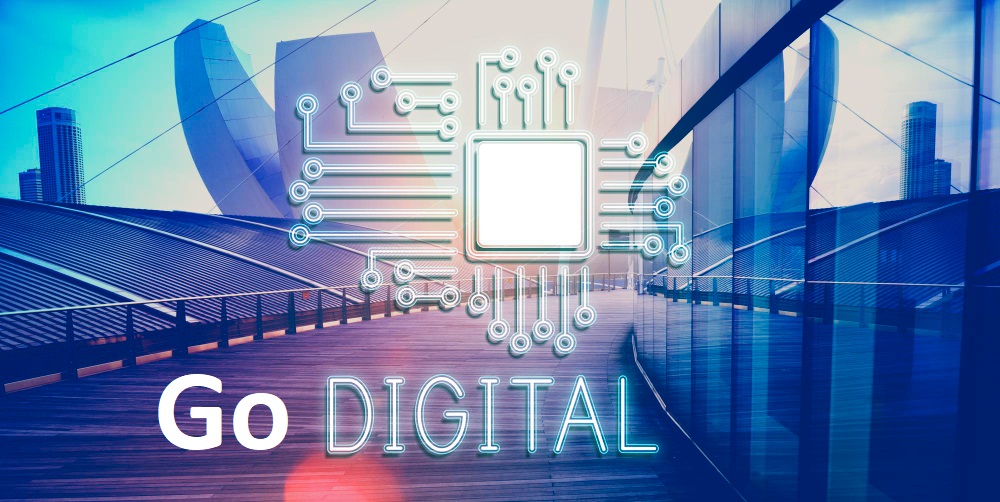Going digital refers to the process of fully transitioning from traditional, analog methods to digital methods in all aspects of business operations and processes. This includes digitizing data, automating processes, and implementing digital communication and collaboration tools. By going digital, businesses and organizations can reap a wide range of benefits such as increased efficiency, cost savings, improved communication and collaboration, better data management and analysis, and increased accessibility and flexibility. Additionally, going digital allows businesses to stay competitive in today’s digital age and adapt to changes in the market and customer needs. However, going digital also requires a significant investment of time and resources, and requires the ability to adapt to new technologies and processes. It’s also important to consider data protection and cybersecurity during the transition to ensure the safety and compliance of data.
What does go digital mean?
“Going digital” generally refers to the process of transitioning from traditional, analog methods of storing and processing information to digital methods. This can include a wide range of activities such as:
- Digitizing analog information, such as photographs, audio recordings, and documents, so that they can be stored and accessed in digital form.
- Using digital technology to improve efficiency, productivity, and communication in various industries and sectors, such as healthcare, finance, and education.
- Adopting digital communication and distribution channels, such as email, social media, and mobile apps, to reach customers and consumers.
- Automating processes and using digital tools to make data-driven decisions in business operations and management.
“Going digital” can also refer to a company or organization’s strategy of transitioning their business processes and operations to take advantage of digital technologies and to leverage the benefits they provide. This could mean for example, moving from paper-based systems to digital systems, such as electronic medical records in healthcare, or replacing traditional point of sales with a digital one in retail.
In the current digital age, “Going digital” is often seen as a necessary step for businesses to stay competitive and relevant, as well as to meet the expectations of customers and consumers who are increasingly using digital technology in their daily lives.
Go completely digital
Going completely digital refers to the process of fully transitioning from traditional, analog methods to digital methods in all aspects of business operations and processes. Here is a guide on how to go completely digital:
- Assess your current state:
- The first step in going completely digital is to assess your current state of operations. Identify which processes and systems are still based on analog methods, and which areas of your business would benefit most from a digital transition.
- Develop a plan:
- Once you have identified the areas that need to be digitalized, develop a plan to transition those processes and systems to digital methods. This plan should include timelines, resources, and milestones for each step of the transition.
- Invest in technology:
- Invest in the technology and software needed to support your digital transition. This may include purchasing new hardware, such as laptops and servers, or investing in cloud-based services and software.
- Train your staff:
- Make sure that your staff is trained on the new digital technologies and processes. This will ensure that they are able to use the new systems effectively and efficiently.
- Implement digital communication and collaboration tools:
- Implement digital communication and collaboration tools, such as email, instant messaging, and video conferencing, to improve communication and collaboration within your organization.
- Automate processes:
- Automate processes as much as possible, such as data entry and record keeping, to reduce the need for manual work and improve efficiency.
- Go paperless:
- Eliminate the use of paper wherever possible, such as by using digital forms and document management systems.
- Monitor and evaluate:
- Continuously monitor and evaluate the progress of your digital transition, and make adjustments as needed.
- Stay current:
- Stay current with the latest digital trends and technologies, and consider how they can be applied to your business.
Going completely digital can provide many benefits, such as improved efficiency, cost savings, and better communication and collaboration. However, it’s important to keep in mind that the process may require a significant investment of time and resources, and requires the ability to adapt to new technologies and processes.
Additionally, it’s important to consider data protection and cybersecurity during the digital transition, to ensure that the data is safe and the business is compliant with regulations.
FAQ – Frequently Asked Questions about Go Digital – Your Web Business
What does it mean to ‘Go Digital’?
‘Go Digital’ refers to the process of transitioning traditional business operations to digital ones, leveraging technologies to improve efficiency, reach, and customer engagement. It includes using digital tools for marketing, sales, customer service, data analysis, and more.
How can businesses benefit from ‘Going Digital’?
By going digital, businesses can reach a larger audience, improve efficiency, reduce costs, and enhance customer experiences. It also allows for better data collection and analysis, leading to more informed decision-making.
What steps are involved in ‘Going Digital’?
‘Going Digital’ involves several steps, including: creating a digital strategy aligned with your business goals, establishing an online presence (website, social media), implementing digital marketing strategies, utilizing digital tools for operations, and leveraging data analytics.
How important is digital marketing in the ‘Go Digital’ process?
Digital marketing is crucial in the ‘Go Digital’ process. It allows businesses to reach their target audience more effectively, engage with customers in real-time, and track the performance of their marketing efforts more accurately.
How can ‘Going Digital’ improve customer service?
‘Going Digital’ can greatly enhance customer service. It can provide more convenient and personalized interactions, 24/7 customer support through chatbots, faster response times, and more accessible customer resources.
What are the challenges of ‘Going Digital’?
‘Going Digital’ does present some challenges, such as the need for digital skills training, data privacy and security concerns, and the need to adapt to fast-changing technologies. However, with strategic planning and implementation, these challenges can be managed.
The ‘Go Digital’ movement refers to the shift from traditional to digital business operations, leveraging technology for improved efficiency and reach. It encompasses aspects like digital marketing, online presence, digital tools for operations, and data analytics, leading to numerous benefits for businesses. However, it does come with certain challenges that require strategic planning and adaptation.





